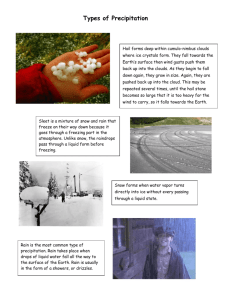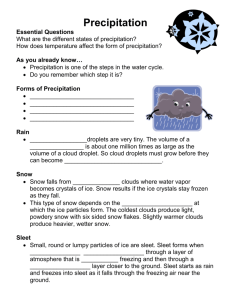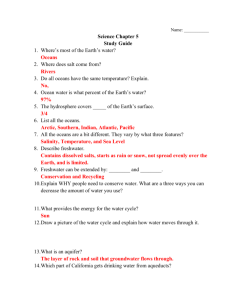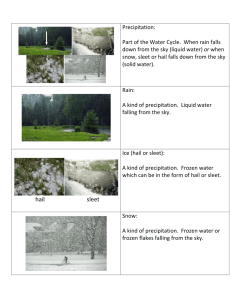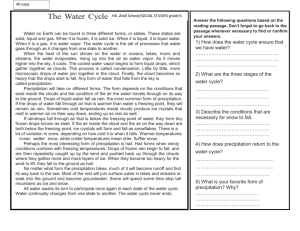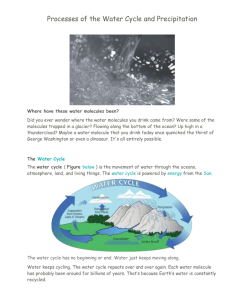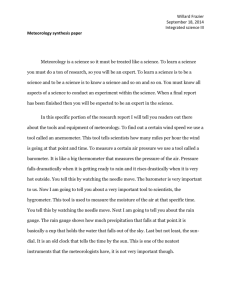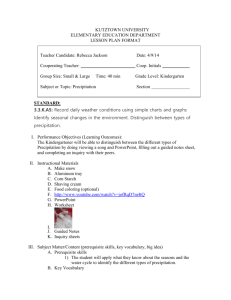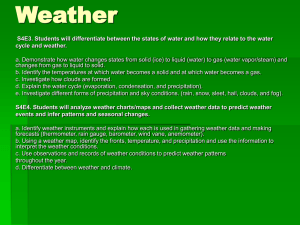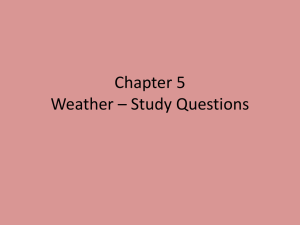File
advertisement
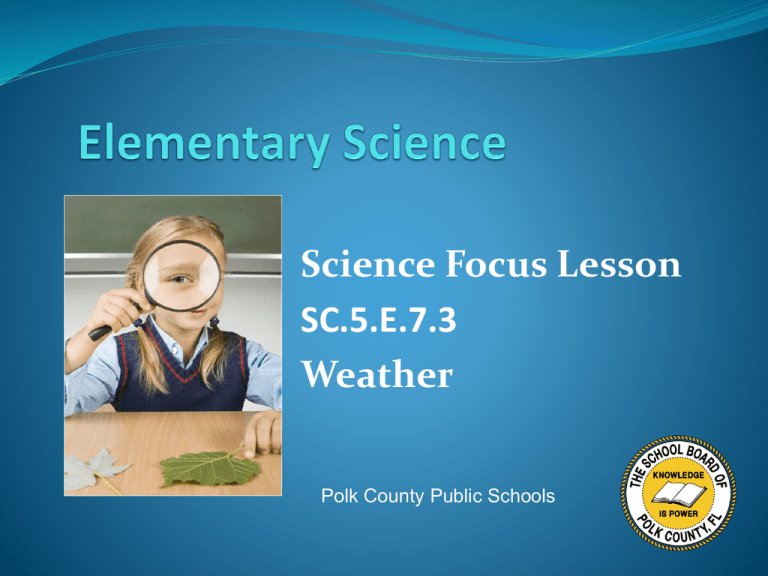
Science Focus Lesson SC.5.E.7.3 Weather Polk County Public Schools SC.5.E.7.3 Benchmark: Recognize how air temperature, barometric pressure, humidity, wind speed and direction, and precipitation determine the weather in a particular place and time. Essential Question: How does temperature, air pressure, humidity, wind speed and direction, and precipitation determine the weather in a particular place and time? Vocabulary: temperature air pressure hail humidity wind speed sleet Weather is the condition of the atmosphere at a place for a short period of time. How is weather described? Weather is described by using air temperature air pressure (barometric pressure) humidity wind speed and direction precipitation Air Temperature Air Temperature is how hot or cold the air is. A thermometer measures the temperature of the air in degrees Celsius or Fahrenheit. The higher the temperature the warmer the weather. The lower the temperature the colder the weather. The temperature falls as the altitude rises. The temperature of land near a large body of water is often moderate because it usually takes longer for the water to cool or heat which keeps the land next to it cooler or warmer. Air Pressure •Air Pressure is also called Barometric Pressure. •Air pressure is the weight of air pressing on everything around it. •Air pressure is measured by using a barometer. Conditions affecting Air Pressure •Three conditions affect air pressure •Water Vapor makes air moist. Moister air has a lower air pressure- drier air has higher air pressure •Temperature – when air gets warmer the pressure goes down and when it gets cooler the pressure goes up. •Altitude – Air at pressure goes down at higher altitudes because the air is thinner. • When the air pressure changes you can tell the weather will change. Rising air pressure means clearer weather is coming. Falling air pressure means unsettled or wet weather is coming. Summarizing 1. Partner A to B: Define weather and terms used to describe weather conditions 2. Partner B to A: What happens to the weather when the temperature rises? 3. Partner A to B: Describe air pressure. 4. Partner B to A: What weather condition is predicted when air pressure rises? Humidity • Water vapor in the air is called humidity. •On very humid days the air is holding a lot of water vapor and your skin may feel damp. •Relative humidity is the amount of water vapor that the air is holding compared with the amount that it could hold at that temperature. •Relative humidity is measured with a hygrometer. Wind Speed and Direction •Wind is moving air. Air moves because the surface of the Earth is not heated evenly. •Wind speed is measured with an anemometer. •Wind direction is measured by a wind vane. •Land near a large body of water often has a sea breeze or a land breeze. Wind Vane Anemometer Precipitation •Water that falls to Earth’s surface is called precipitation. Sleet-small pellets of ice Sleet falls at below freezing temperatures. Snow – ice in the form of six sided crystals - Measured with a snow gauge Snow may fall when temperature reaches freezing. Hail- chunks or balls of ice Hail can fall at above freezing temperatures. Rain – Liquid drops Measured with a rain gauge Rain falls at above freezing temperatures. Clouds Each kind of cloud tends to go with a different kind of weather Cirrus clouds may be followed by rain or snow in a few hours. Stratus clouds can bring light rain. Cumulonimbus clouds produce thunderstorms- they are also called thunderheads Cumulus clouds are “fairweather” clouds Summarizing Talk with your partner to answer the following question What characteristic of weather would explain why your skin feels damp during the summer months in Florida? Guided Instruction: Which tool is used to measure how much rain falls during a storm? A. B. C. D. The answer is A rain gauge is used to measure the amount of rain fall. Guided Instruction: Grace's class measured the temperature outside four times a day for four days in a row. Their results are shown below. Which two days were most likely cloudy based on the results? A. Day1 & Day 2 B. Day 2 & Day 3 C. Day 3 & Day 4 D. Day 4 & Day 1 The answer is The two days are Day 2 and 3 because the temperature does not increase much during the day. When clouds are present there is less direct sun light which does not allow for much heating of the air. Guided Instruction Jenny measures the outside temperature as 16 degrees Celsius, 61 degrees Fahrenheit. She observes precipitation falling from the clouds in a solid form. What type of precipitation is Jenny most likely observing? A. hail B. rain C. sleet D. snow The answer is Hail is solid precipitation that forms high in the atmosphere where the temperature is below freezing even though the surface temperature is above freezing. Guided Instruction: Which tool is used to measure the winds speed? A. B. C. D. The answer is Anemometer is used to measure the speed of the wind. Summarizing Essential Question: How can clouds help us to make predictions about changes in the weather? Check Your Understanding 1. Which tool is used to measure wind direction? A. B. C. D. Check Your Understanding 2. Alexis measures the outside temperature as 16 degrees Celsius, 61 degrees Fahrenheit. She observes precipitation falling from the clouds in a liquid form. What type of precipitation is Jenny most likely observing? A. hail B. rain C. sleet D. snow Check Your Understanding 3. Grace's class measured the temperature outside four times a day for four days in a row. Their results are shown below. Which two days were most likely sunny based on the results? A. Day1 & Day 2 B. Day 2 & Day 3 C. Day 3 & Day 4 D. Day 4 & Day 1 Check Your Understanding 4. Philip measured the temperature on the top of the Grand Teton mountains in Wyoming and the temperature at the lowest point in the valley below. Which of the following descriptions would best describe the temperatures that Philip measured? A. The temperature on the top of the mountain much higher than the temperature in the valley. B. The temperature on the top of the mountain was cooler than the temperature in the valley. C. The temperature on the top of the mountain was a little higher than the temperature in the valley. D. The temperature on the top of the mountain was the same as the temperature in the valley. Check Your Answers 1. 2. 3. 4. C. Wind Vane B. Rain D. Day 4 and Day 1 B. The temperature on the top of the mountain was cooler than the temperature in the valley. Summary Question With your shoulder partner, list the characteristics of weather that are reported on by a meteorologist.
